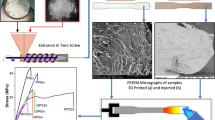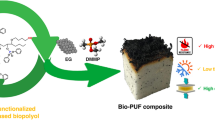Abstract
In this paper, the waste graphite/expanded polystyrene was used as a raw material to prepare recycled graphite/expanded (rGEPS) foam board. A convenient and facile way to regenerate graphite/polystyrene beads was proposed in this work. This can be applied in the further industrial production. The solvent could be recycled, which made the process more efficient and economic. The rGEPS beads were analyzed by TGA, FTIR and XRD. The results indicated that the properties were not deteriorated. Then, the test results of rGEPS foam board, such as water absorption, apparent density, bending strength, compressive strength, thermal conductivity and oxygen index, showed that the properties have reached enterprise standards of expanded polystyrene (EPS) foam board. The thermal conductivity was decreased by 13.16% compared with EPS foam board. Therefore, the prepared rGEPS foam board could be considered as a candidate of the thermal insulation materials in construction.





Similar content being viewed by others
References
John B, Reghunadhan Nair CP (2014) 13-Syntactic foams. In: Dodiuk H, Goodman SH (eds) Handbook of thermoset plastics, 3rd edn. William Andrew Publishing, Boston, pp 511–554. https://doi.org/10.1016/B978-1-4557-3107-7.00013-0
Bhutta MAR, Ohama Y, Tsuruta K (2011) Strength properties of polymer mortar panels using methyl methacrylate solution of waste expanded polystyrene as binder. Constr Build Mater 25:779–784. https://doi.org/10.1016/j.conbuildmat.2010.07.006
Aciu C, Manea DL, Molnar LM, Jumate E (2015) Recycling of polystyrene waste in the composition of ecological mortars. Proc Technol 19:498–505. https://doi.org/10.1016/j.protcy.2015.02.071
Abdallah MA-E, Sharkey M, Berresheim H, Harrad S (2018) Hexabromocyclododecane in polystyrene packaging: a downside of recycling? Chemosphere 199:612–616. https://doi.org/10.1016/j.chemosphere.2018.02.084
Brennan LB, Isaac DH, Arnold JC (2002) Recycling of acrylonitrile-butadiene-styrene and high-impact polystyrene from waste computer equipment. J Appl Polym Sci 86:572–578. https://doi.org/10.1002/app.10833
Rani M, Shim WJ, Han GM, Jang M, Song YK, Hong SH (2014) Hexabromocyclododecane in polystyrene based consumer products: an evidence of unregulated use. Chemosphere 110:111–119. https://doi.org/10.1016/j.chemosphere.2014.02.022
Sarmiento AM, Guzman HL, Morales G, Romero DE, Pataquiva-Mateus AY (2016) Expanded polystyrene (EPS) and waste cooking oil (WCO): from urban wastes to potential material of construction. Waste Biomass Valorization 7:1245–1254. https://doi.org/10.1007/s12649-016-9511-7
Chaukura N, Gwenzi W, Bunhu T, Ruziwa DT, Pumure I (2016) Potential uses and value-added products derived from waste polystyrene in developing countries: a review. Resour Conserv Recycl 107:157–165. https://doi.org/10.1016/j.resconrec.2015.10.031
Mohamed OA, Kassem NF (2010) Utilization of waste leather shavings as filler in paper making. J Appl Polym Sci 118:1713–1719. https://doi.org/10.1002/app.32315
Shibamoto T, Yasuhara A, Katami T (2007) Dioxin formation from waste incineration. In: Ware GW (ed) Reviews of environmental contamination and toxicology. Springer, New York, pp 1–41. https://doi.org/10.1007/978-0-387-36903-7_1
Bekri-Abbes I, Bayoudh S, Baklouti M (2006) Converting waste polystyrene into adsorbent: potential use in the removal of lead and cadmium ions from aqueous solution. J Polym Environ 14:249–256. https://doi.org/10.1007/s10924-006-0018-3
Lipshutz BH, Gallou F, Handa S (2016) Evolution of solvents in organic chemistry. ACS Sustain Chem Eng 4:5838–5849. https://doi.org/10.1021/acssuschemeng.6b01810
Costa P, Pinto F, Ramos AM, Gulyurtlu I, Cabrita I, Bernardo MS (2010) Study of the pyrolysis kinetics of a mixture of polyethylene, polypropylene, and polystyrene. Energy Fuels 24:6239–6247. https://doi.org/10.1021/ef101010n
Hussain Z, Khan KM, Perveen S, Hussain K, Voelter W (2012) The conversion of waste polystyrene into useful hydrocarbons by microwave-metal interaction pyrolysis. Fuel Process Technol 94:145–150. https://doi.org/10.1016/j.fuproc.2011.10.009
Mo Y, Zhao L, Chen C-L, Tan GYA, Wang J-Y (2012) Comparative pyrolysis upcycling of polystyrene waste: thermodynamics, kinetics, and product evolution profile. J Therm Anal Calorim 111:781–788. https://doi.org/10.1007/s10973-012-2464-6
Koopmans RJ, Doelder JCFd, Paquet AN (2000) Modeling foam growth in thermoplastics. Adv Mater 12:1873–1880
Jin SM, Cui KX, Guan HY, Yang M, Liu L, Lan CF (2012) Preparation of mesoporous MCM-41 from natural sepiolite and its catalytic activity of cracking waste polystyrene plastics. Appl Clay Sci 56:1–6. https://doi.org/10.1016/j.clay.2011.11.012
Miller-Chou BA, Koenig JL (2003) A review of polymer dissolution. Prog Polym Sci 28:1223–1270. https://doi.org/10.1016/s0079-6700(03)00045-5
Shikata S, Watanabe T, Hattori K, Aoyama M, Miyakoshi T (2011) Dissolution of polystyrene into cyclic monoterpenes present in tree essential oils. J Mater Cycles Waste Manag 13:127–130. https://doi.org/10.1007/s10163-011-0005-1
Santiago LM, Masmoudi Y, Tarancón A, Djerafi R, Bagán H, García JF, Badens E (2015) Polystyrene based sub-micron scintillating particles produced by supercritical anti-solvent precipitation. J Supercrit Fluids 103:18–27. https://doi.org/10.1016/j.supflu.2015.04.015
Gutiérrez C, Rodríguez JF, Gracia I, de Lucas A, García MT (2014) Preparation and characterization of polystyrene foams from limonene solutions. J Supercrit Fluids 88:92–104. https://doi.org/10.1016/j.supflu.2014.02.002
Achilias DS, Giannoulis A, Papageorgiou GZ (2009) Recycling of polymers from plastic packaging materials using the dissolution–reprecipitation technique. Polym Bull 63:449–465. https://doi.org/10.1007/s00289-009-0104-5
Mangalara SCH, Varughese S (2016) Green recycling approach to obtain nano- and microparticles from expanded polystyrene waste. Acs Sustain Chem Eng 4:6095–6100. https://doi.org/10.1021/acssuschemeng.6b01493
Gutiérrez C, García MT, Gracia I, de Lucas A, Rodríguez JF (2012) The selective dissolution technique as initial step for polystyrene recycling. Waste Biomass Valorization 4:29–36. https://doi.org/10.1007/s12649-012-9131-9
Garcia MT, Gracia I, Duque G, Lucas A, Rodriguez JF (2009) Study of the solubility and stability of polystyrene wastes in a dissolution recycling process. Waste Manag 29:1814–1818. https://doi.org/10.1016/j.wasman.2009.01.001
Patino-Herrera R, Catarino-Centeno R, Gonzalez-Alatorre G, Goicochea AG, Perez E (2017) Enhancement of the hydrophobicity of recycled polystyrene films using a spin coating unit. J Appl Polym Sci. https://doi.org/10.1002/app.45365
Cella RF, Mumbach GD, Andrade KL, Oliveira P, Marangoni C, Bolzan A, Bernard S, Machado RAF (2018) Polystyrene recycling processes by dissolution in ethyl acetate. J Appl Polym Sci. https://doi.org/10.1002/app.46208
Musto P, La Manna P, Pannico M, Mensitieri G, Gargiulo N, Caputo D (2018) Molecular interactions of CO2 with the CuBTC metal organic framework: an FTIR study based on two-dimensional correlation spectroscopy. J Mol Struct 1166:326–333. https://doi.org/10.1016/j.molstruc.2018.04.058
Roghani-Mamaqani H, Khezri K (2016) A grafting from approach to graft polystyrene chains at the surface of graphene nanolayers by RAFT polymerization: various graft densities from hydroxyl groups. Appl Surf Sci 360:373–382. https://doi.org/10.1016/j.apsusc.2015.11.041
Hadi A, Zahirifar J, Karimi-Sabet J, Dastbaz A (2018) Graphene nanosheets preparation using magnetic nanoparticle assisted liquid phase exfoliation of graphite: the coupled effect of ultrasound and wedging nanoparticles. Ultrason Sonochem 44:204–214. https://doi.org/10.1016/j.ultsonch.2018.02.028
Visscher WM, Bolsterli M (1972) Random packing of equal and unequal spheres in two and three dimensions. Nature 239:504–507. https://doi.org/10.1038/239504a0
Kausch HH, Fesko DG, Tschoegl NW (1971) The random packing of circles in a plane. J Colloid Interface Sci 37:603–611. https://doi.org/10.1016/0021-9797(71)90338-9
Attila Y, Güden M, Taşdemirci A (2013) Foam glass processing using a polishing glass powder residue. Ceram Int 39:5869–5877. https://doi.org/10.1016/j.ceramint.2012.12.104
Bedeaux D, Kapral R (1983) The effective reaction rate and diffusion coefficients for a two-phase medium. J Chem Phys 79:1783–1788. https://doi.org/10.1063/1.446023
Leach AG (1993) The thermal conductivity of foams. I. Models for heat conduction. J Phys D Appl Phys 26:733–739. https://doi.org/10.1088/0022-3727/26/5/003
Collishaw PG, Evans JRG (1994) An assessment of expressions for the apparent thermal conductivity of cellular materials. J Mater Sci 29:2261–2273. https://doi.org/10.1007/bf00363413
Kuhn J, Ebert HP, Arduini-Schuster MC, Büttner D, Fricke J (1992) Thermal transport in polystyrene and polyurethane foam insulations. Int J Heat Mass Transf 35:1795–1801. https://doi.org/10.1016/0017-9310(92)90150-Q
Wrj J, Ac M (1983) Thermal conductivity of plastic foams. Polym Eng Sci 23:293–298. https://doi.org/10.1002/pen.760230602
Ball GW, Hurd R, Walker MG (1970) The thermal conductivity on rigid urethane foams. J Cell Plast 6:66–75. https://doi.org/10.1177/0021955x7000600202
Almanza O, Rodríguez-Pérez M, De Saja JA (1999) Thermal conductivity of polyethylene foams manufactured by a nitrogen solution process. Cell Polym 18:385–401
Chung DDL (2002) Review graphite. J Mater Sci 37:1475–1489. https://doi.org/10.1023/A:1014915307738
Li L, Hu YH, Gu YL, Zhao YZ, Yu L, Huang BK (2017) Infrared extinction performance of biological materials. Spectrosc Spectr Anal 37:3430–3434. https://doi.org/10.3964/j.issn.1000-0593(2017)11-3430-05
Acknowledgements
This work was supported by the Graduated Innovation Fund of Jilin University (Project 2015082).
Author information
Authors and Affiliations
Corresponding author
Ethics declarations
Conflict of interest
The authors declare that they do not have any commercial or associative interest that represents a conflict of interest in connection with the work submitted.
Rights and permissions
About this article
Cite this article
Yang, J., Li, S., Jiang, H. et al. Preparation of recycled graphite/expanded polystyrene by a facile solvent dissolution method. J Mater Sci 54, 1197–1204 (2019). https://doi.org/10.1007/s10853-018-2890-3
Received:
Accepted:
Published:
Issue Date:
DOI: https://doi.org/10.1007/s10853-018-2890-3




